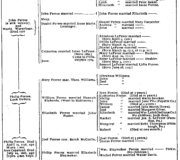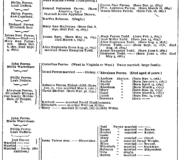THE SHRIVER FAMILY GREEN BOOK.
PART SECOND. NARRATIVES AND RECORDS TO THE PRESENT TIME. 1888.
(Page numbers from 1888 Green Book in [square brackets].)
![]()
Early Settlement of the Ferrees (Le Fieres)
in Pequa (Piquaw) Valley, Pa.
[37]
The following additional information of the Ferree family branch is derived from an address, with appendix, by Redmond Conyngham, delivered at Paradise, Pa., 1842; and from data furnished by Samuel P. Ferree, Philadelphia, a descendant of the Piques family.
Extracts, etc. — “The celebrated Edict of Nantes granted to Protestants security for their rights, but it was revoked by Louis XIV. on the 23d day of October, 1685. * * In 1686 the Huguenots landed at New York. Some went to Esopus, on the North river, others to New Rochelle, and some to Philadelphia.
“Among the sufferers in France at that eventful period was the family of Le Fiere, or Ferree. John Le Fiere had married a woman of rare endowments, Mary Warrimbere. Their children were Daniel, Philip, John, Catharine, Mary, Jane. On the destruction of the Protestant Establishments, the family removed to Strasburg, on the Rhine, then, for greater security, to Lindau, a walled town in lake Constance, on the borders of Switzerland. Here they remained two years, but on the death of her husband Mary went to Holland. The character of this lady was tinctured with uncommon resolution and intrepidity. She had left the land of her nativity forever; the tie of love of country had been rudely broken, and she resolved to seek the benevolent founder of Pennsylvania. With this view, accompanied by her children, she went to London in the year 1704; from thence she visited William Penn at his residence in Kensington, where he resided to be near Queen Anne, of whom he was a distinguished favorite.
“William Penn became interested for the unfortunate Mary Le Fiere, moved by the sad tale of her sufferings and the vicissitudes she had undergone. He received her into his house, introduced her [38] to the Queen, who, commiserating her condition, promised her aid on emigrating to the ‘Land of Penn.’ William Penn procured lodgings for her in the vicinity, where she remained until the ‘vessel bound to the North river’ was ready to sail with emigrants. The Queen provided her with ploughs, harrows, axes, hatchets, saws, hand-mill for grinding corn, etc. Mary Le Fiere arrived at New York about eight months afterwards, and first visited Esopus, then went to Philadelphia, taking with her letters to Penn’s agent, with a grant for two thousand acres of land. She found the Huguenots dissatisfied with their situation, the vineyards* not proving profitable, which they resolved to abandon and join Madame Le Fiere in the proposed settlement among the Piquaws, whose king had been a favorite of Penn’s, and the location was strenuously recommended to Madame Le Fiere by the kind agent. The little band of emigrants reached the valley of the Piquaws. The foliage of the forests was rich and diversified. There was something singularly beautiful and picturesque in the disposition of the Indian cottages amidst coppices of luxuriant hazel extending far and wide. The great flats of Pequea, on which king Tanawa resided, presented the appearance of a cultivated meadow surrounding the several Indian cabins. All was stillness; not a sound to disturb the general tranquility. Suddenly a group of Indians stood before them. The fears of the emigrants were soon dispelled, for, in broken English, they bid them welcome. The Piquaws supplied the infant settlement with provisions. King Tanawa gave them a kind reception. The great flats of Pequea were natural meadows on which grass grew luxuriantly, which proved a great source of comfort to the new settlers. The Indians were scattered along the banks of the Pequea, every wigwam being governed by a chief who was subject to Tanawa. Tanawa had known William Penn, and called him the `Indians’ friend.’ He frequently reminded the settlers of the promise made by Penn, the great father from the wide waters, when they intruded upon his rights.”
*Some of the Huguenots settled on the Schuylkill, near Philadelphia, where they had a vineyard. Not far distant another attempt to cultivate the grape was made by De La None, Le Fevre, Dubois, Boileau, Larroux, etc.
Isaac Le Fevre, whose life and history has been prominently connected [39] with that of the Ferrees, it is stated, was born in 1669, and in 1709 came to Philadelphia from Esopus, having married Catharine Ferree soon after their arrival in this country. Mr. Conyngham, in his address, refers to him as follows: “And now let me turn. your attention to a youth of fourteen; his parents had perished in the religious wars which had, desolated France — an orphan — friendless — travelled through Holland — went to London where he Made his intentions known to William Penn. Alone? Oh! no; he had one companion — his consolator in Europe — in Pennsylvania — his Bible. That young lad was Isaac Le Fevre. That Bible is still preserved by the family of Le Fevre as a most precious relic.”
In reference to the early settlement at Pequea it is stated that Tanawa, the king of the Piquaws, had sold the land under his jurisdiction to Penn, and, therefore, threw no impediment in the way of its settlement. At the time of the Ferree settlement in his dominion Mary Le Fiere took a present from Penn’s agent to. Tanawa, and thus secured his friendship.
“She had a grant of 2,000 acres. Daniel Ferree had a promisory grant of 2,000 acres.”
“Philip Ferree married Leah, the daughter of Abraham Dubois, and was presented with the grant held by Dubois for 2,000, acres.”
“Isaac Le Fevre held a grant for 2,000 acres, and also obtained an additional grant by his marriage with Catharine Ferree. Their son was the first white child born in the valley of the Pequea.”
“Mary Le Fiere, or Ferree, vested in trustees a piece of land near Paradise as a burial place for the use of the settlement. It is neatly walled, and kept in good condition by the neighbors whose ancestors repose within its limits,”
“The name of Mary Ferree will long be held in grateful remembrance by her numerous and warm-hearted progeny.”
It is further stated, that “a number of Irish emigrants settled early on the hazel land, made ditches, and planted hedges of privet for fences from the want of trees. They mostly removed to the southern part of the county (Lancaster) where they formed what was called the ‘Scotch-Irish Settlement,’ having disposed of their improvements on the Pequea to the Germans.”
[40]
The following is an extract from a letter of Governor Pownall descriptive of Pequea Valley in 1754: “I passed through the hills over a rough road, six miles and a-half to the widow Caldwell’s at the ‘Hat,’ and then entered the beautiful valley of Pequea. The vale is formed by the Valley Hill on the south and the Welsh Mountain on the north. My next stage was six miles and a half to the ‘Red Lion,’ then to Conestoga, a large stream, four miles, thence to Lancaster, two miles. Lancaster is a wealthy and thriving town, about five hundred inhabitants, manufacturing saddle, pack-saddles, guns — Indian traders, stocking weavers.
“Pequa affords a pleasant prospect— a rich landscape — farmhouses surrounded with apple and peach trees. The farmers, proprietors, not tenants. On every farm a lime-kiln, and the land adapted for the best of wheat. On inquiry, the finest farms are all owned by Switzers. Land of farms sells readily at three pounds an acre. On the east side of the hills at five pounds per acre.”
The town of Lancaster, thus described, was situated between the Conewago and Pequea settlements, and the custom then prevailing of holding fairs, for the diversion of the people, brought these early settlers together at Lancaster. It was at one of these fairs that the young German yeoman, David Shriver, first met Rebecca Ferree, who was receiving instruction at a school in Lancaster, and their subsequent marriage joined in goodly fellowship these vigorous representative families of their respective settlements and nationalities.
Samuel P. Ferree, of Philadelphia, has kindly furnished the records of several branches of the Ferree family, which are annexed to this narrative, and which evidence its present numerical importance and respectability. It is a matter of interest, in this connection, to note the similarity of the growth and extension of the family throughout the state and country with that of the Shriver family.
It would be interesting to follow these records throughout all the branches, showing in what manner the descendants have formed alliances, and widened their connections and influence East [41] and West. It is a praiseworthy fact that the family has a member in Mr. Ferree loyal to its history and traditions.
Among matters of interest in his possession is a carefully prepared plot of the original Ferree estate in Pequea valley, indicating its subsequent apportionment among the members. And also a marriage license bond in the interest of the union of Andrew Ferree and Mary Ferree which reads as follows: “Know all men by these presents, that Andrew Ferree and Abraham Le Fevre, both of Lancaster county, yeomen, are held firmly bound unto Joseph Reed, Esquire, President of the Supreme Executive Council of the Commonwealth of Pennsylvania, Captain General and Commander-in-Chief in and over the same, in the sum of four thousand pounds, to be paid to the said Joseph Reed, Esq., his certain Attorney, etc., etc. — Dated the 8th of July, 1780. The conditions of this obligation are such that if there shall not hereafter appear any lawful let or impediment by reason of any pre-contract consanguinity, affinity, or any other just cause whatsoever, but that the above mentioned Andrew Ferree and Mary Ferree may lawfully marry,” etc. These old-time marriage safeguards are worthy of consideration in these later days.
The Ferree family, according to the above data, must have reached this country in 1704 or 1705. Allowing for the visit to Esophus, North river, New York, the settlement at Pequea was made a year or two later. Mary Ferree, as stated, died in 1716. Her descendants have been connected, by marriage, with a number of the well-known families of the State, some of whose ancestors identified with the Pequa settlement dating from 1718 onward.



